History of Rowing Victoria Inc
- Table of Contents
- Introduction
- Chapters
- 1: Rowing in a young Victoria 1838-1859
- 2: Formation of the Association 1860-1875
- 3: Growth of the Sport 1876-1889
- 4: Years of great success 1890-1899
- 5: The rise of Australian Henley 1900-1909
- 6: The War Years 1910-1919
- 7: Women's rowing and the modern era 1920-1929
- 8: The Depression Rebuild 1930-1939
- 9: War and rebuilding 1940-1949
- 10: Expansion years 1950-1959
- 11: The search for international success 1960-1969
- 12: Combining the Associations and lightweight success 1970-1979
- 13: The new national program 1980-1989
- 14: Golden years 1990-1999
- 15: Professionalism 2000-2009
- 16: Yet More Growth 2010-2019
- 17: Changing Times 2020-2026
- Appendices
- 1: Life Membership and other important awards
- 2: Patrons and Presidents
- 3: Office Bearers
- 4: Clubs and their histories
- 5: The Oarsmen's Centotaph and WWI Roll of Honour
- 6: WWII Roll of Honour
- 7: Premierships
- 8: State Championships
- 9: Hall of Fame Inductees
- 10: Victorian Olympians
- 11: International representation
- 12: Intercolonial and Interstate Racing
- 13: School rowing
- 14: University rowing
- 15: Histories of Victorian Rowing
- 16: Annual Reports
1. Rowing in a young Victoria, 1838 to 1859 - this chapter is under construction
Rowing in Victoria prior to the gold rush 1838-1851
Page 1 - Rowing in Victoria prior to the gold rush 1838-1851
Page 2 - The gold rush and the subsequent rush to rowing 1851-1859
Page 3 - Rowing around Australia to 1859
Synopsis
The first settlers of Victoria wasted no time in starting rowing with the first regatta held on the third anniversary of the settlement of Melbourne in 1838. It drained the settlement of people as they went down to Port Phillip to watch the event. The early promoters of rowing were members of the newly formed Melbourne Club. They were soon replaced by commercial promoters such as hoteliers who gained the most from organising a successful event. The pre-occupation with their economic problems of the Melbourne Club gentlemen was also an important factor. The Melbourne recession of 1842-44 and a subsequent paucity of active rowers led to competitions being of variable quality or cancelled. However, the thriving young city of Geelong picked up where Melbourne left off conducting events on Corio Bay. Most regattas in both centres were conducted jointly with sailing on open water.
Beyond the sport of rowing, Melbourne was established in the period 1851-1861. Dr Geoffrey Searle in his book "The Golden Age" called this period "The Golden Years". There was good reason for this. Despite the Gold Rush commencing in 1851 and the almost overwhelming difficulties of the situation, distinguished commentators observe that the leaders of this period laid in Victoria the solid foundation of enlightened future prosperity. In this period of ten years they organized the administration of justice and the police; established an unusual system of education; reformed the financial administration; and started great institutions such as the Public Library, the Museums, and the University. They provided a system of local government and organized the creation and maintenance of means of communication. They did this in the face of a social, political and economic revolution that shook the community to its very foundations, and which would have overthrown the civilization of many a State which had an established tradition of fifteen hundred instead of fifteen years to rely on. Commentators rightly gave full credit to the men of the period who presented an unflinching front to the threats of anarchy and the temptation of private gain.
Unlike the earlier settlements of Sydney and Hobart, Melbourne's first settlement did not commence until the relatively late date of 1835.
The recognised commencement date of the Melbourne town is 30th August 1835, when it was settled by John Pascoe Fawkner. This date is confirmed by contemporary reports in 18411. The early settlors were largely immigrants from Tasmania. Fawkner founded the town on the site identified by John Batman. There appears to have been some contemporary debate as to who was the true founder of the township between Batman who identified the site, and Fawkner who settled it. This is evident in the reports of the first regatta in 1838 which is described later on this page.
Compared to the established towns in Hobart and Sydney, regattas in Victoria took some time to get embedded as part of the activities of these towns. The difficulty in matching the scale and importance of regattas conducted in the Sydney and Hobart townships becomes evident in these early years of Melbourne town. This changed in later years with Victoria becoming the leader in amateur rowing.
The early commencement of rowing in Geelong is another highlight of this pre-gold rush period. The Geelong regattas outpaced Melbourne towards the end of the 1840-50 decade.
Early rowing in Victoria
Like other areas of Australian, the first competitive rowing undertaken in Victoria was between crews of visiting ships. Ships in port usually tested their boats and crews. Further races, usually for a wager, were conducted to keep crews and officers amused. Later these led to shore crews challenging crews from ships.
There are no records of these races and so it is impossible to accurately record the first rowing race in Victoria.
The first regatta
However, we can assess with a high degree of certainty, that the first regatta was conducted on 30th August 1837, at an event commemorating the third anniversary of the Melbourne settlement.
Ralph Neale in his history of early yachting in Victoria2, pin points this date of Victoria's first regatta. He concludes, largely through much good evidence, that a rowing race was conducted between crews of visiting ships on the third anniversary of the settlement of Melbourne. It was witnessed by the two rivals for the status of founder of the town of Melbourne, Fawkner and Batman, and most Melbourne residents. His logic and evidence is compelling. Excerpts of his account follows.
"The Melbourne regatta took place on the Eudora's second voyage to Melbourne, in 1838. The date is pinpointed in the diary of the first clergyman to settle in Melbourne, the Reverend William Waterfield. Under the date of 30 August 1838 appears the following entry:
'Thursday August 30: Today the town was very much emptied on account of the regatta in the Bay. This was the first of the kind at Port Phillip. May it be the last. Would that the people were as jealous for the promotion of the spiritual welfare of the Colony and for the salvation of their souls.'"
And later Neale adds: "It has always been the custom for ships, while in port, to launch their lifeboats and carry out exercises. Sometimes regattas were arranged between crews of ships in port. From Sydney shipping reports, other ships at William's Town on 30 August 1838 included the schooner Bessy which departed the same day, and the schooner Edward which sailed the following day. Did Captain Addison, 'ever ready friend of the poor, a kind frank and open hearted captain', arrange the regatta to amuse his crew and repay some of the local hospitality or did the event celebrate an anniversary? The presence of the two rival founders of Melbourne, John Pascoe Fawkner in a London waterman's rig, and John Batman afloat in his whaleboat with his Sydney Aborigines, and the fact that the small town was deserted and the Reverend Waterfield was lamenting, suggest an important occasion."
The author of this history concurs with Neale and adopts this event on 30th August 1938 as the first organised rowing regatta in Victoria. No doubt earlier races were held, but this was a regatta with spectators, dignitaries and no doubt waging. It was a significant event for the fledgling town of Melbourne.
Melbourne continued to grow steadily but for many years it was in survival mode. Recreation was a luxury.
Rowing no doubt continued as an open water sport between seafarers visiting Port Phillip. Any races would have been conducted in working boats given that they were the only boats available. The sleek river 'wager' boats were still some time off.
George Arden, the editor of his Port Phillip newspaper, tried to organise a regatta on 23 December 1839 and raised subscriptions for substantial prizes. However weather intervened and the regatta was cancelled. Flooding rain in December 1839 flooded the river plains of the Yarra River including the brickworks behind where the Princes Bridge rowing clubs now stand. The damage to the town was substantial and the subscriptions for the regatta dried up.
John Batman (1801-1839)
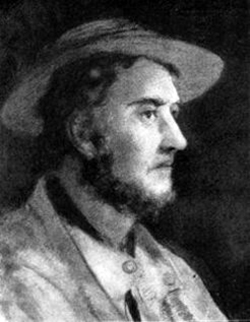
John Batman by James Flett
La Trobe Picture Collection, State Library of Victoria, H29825
Born in Paramatta NSW, Batman moved to Tasmania as a young man of 20 years. During his time in Tasmania, mostly as a grazier, his treatment of the indigenous population was reportedly very bad. The situation is perhaps more complex than described Tasmanian Governor George Arthur, who observed, Batman "...had much slaughter to account for". He was noted for his leadership in the first conciliation campaign amongst the Tasmanian Aboriginals and wrote of 'that much injured and most unfortunate race'. Arthur also called him 'one of the few who supposed that they might be influenced by kindness'.
He sought a grant of land in Port Phillip but was refused. He explored the Port Phillip area in early 1835 and noted in his diary that the area of the current site of Melbourne was a suitable site for a village well supplied with rushing fresh water.
Upon his return to Port Phillip with his family in 1836, he built his house on Batman Hill on western edge of the city district. Poor health followed and he died in 1839.
Source: P. L. Brown, 'Batman, John (1801–1839)', Australian Dictionary of Biography, National Centre of Biography, Australian National University, https://adb.anu.edu.au/biography/batman-john-1752/text1947, published first in hardcopy 1966, accessed online 7 May 2022.
John Pascoe Fawkner (1792–1869)
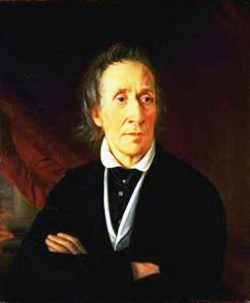
John Pascoe Fawkner by William Strutt
National Library of Australia, nla.pic-an2268302
Fawkner was born in London and immigrated to Australia as a child with his family in 1803. The combined free settlers and convicts and their families were sent to Port Phillip to establish a settlement. The settlement failed and they were moved to Van Diemen's Land. He grew up farming and picked up other trades.
After a varied life of living on the edge and with confrontations with the law in Tasmania, he arranged for an expedition to settle in Port Phillip. He was not to accompany the initial expedition with settled the current site of Melbourne due to having to settle some debts in Launceston. On 30 August 1835 (now Foundation Day or Melbourne Day) the settlers disembarked. The Fawkners arrived in the Port Phillip District on Friday 16 October, on the second trip of the Enterprise. Employees in Fawkner's Party begin clearing the paddock below Pleasant Hill. John Batman arrived later and built his house on Batman's Hill.
He became a man of property and influence, Fawkner took an active and leading part in the political and social struggles of the time. He became an institution of Melbourne. His ADB biographer Hugh Anderson concluded: His triumph over heredity and early experiences and his struggles with autocracy, convictism and corruption, demonstrated the strength of his purpose, and his rehabilitation and later career were remarkable.
Source: Hugh Anderson, 'Fawkner, John Pascoe (1792–1869)', Australian Dictionary of Biography, National Centre of Biography, Australian National University, https://adb.anu.edu.au/biography/fawkner-john-pascoe-2037/text2517, published first in hardcopy 1966, accessed online 14 May 2022.
1840 gigs race on the Yarra
Neale then continues by describing a race conducted in gigs organised by members of the newly formed Melbourne Club, established 1838. Although a substantial wager no doubt would have accompanied the event, it was probably the first amateur race in Victoria3. This amateur claim may seem contradictory given the substantial stake money. However, not for the rowers of that time. The term amateur referred more to the nature of the competitors rather than whether money was involved. These rowers were gentlemen rather than labourers, watermen, or others who worked with their hands. This English based distinction was one which caused much grief in Australian rowing for the rest of the nineteenth century.
"On 2 August 1840 two gigs competed in a race on the Yarra, from Queens Wharf down to the junction of the Yarra with Saltwater river (Maribyrnong) and back again. The contest was a disappointing spectacle, for the Sabina won by half a mile from the Red Rover in the time of 1 hr 15 min. The crews were:
| Sabina | Red Rover | ||
| Charles Henry Le Soeuf | Melbourne Club | Whitehead | |
| Francis Vignoles | Army Officer, Melbourne Club | Daniel Stodhart Campbell | Merchant, Melbourne Clud |
| Templar | Fowler (probably Henry) | Squatter, Melbourne Club | |
| John Thomas Cobb | Squatter, Melbourne Club | John Templeton | Squatter, Melbourne Club |
| Steersman - Rogers | Customers Department | Captain John Roach | Skipper's agent, port Phillip Club |
"This event seemed to stir memories of past rowing triumphs in the mind of Mr Kell, who had recently begun a boatbuilding and repair business on the Yarra at Queen's Wharf. He wagered he could scull a boat over the same course in the same time. But by the appointed day his boat was not yet built and he had to forfeit his 10 pound stake."
1841 regatta
The next regatta was held on 12th January 1841 and again the crowds were said to be significant. It was again organised by the Melbourne Club who had aspirations of matching the regattas held by both Sydney and Hobart. They raised subscriptions of 213 pounds to run the regatta, and as with all regattas of the day, it was a combined rowing and sailing event.
It was reported that both the beaches at William's Town and Port Melbourne were filled with spectators with nearly all the population present.
Neale described the rowing races as follows4:
"The second event was a rowing race in five-oared whaleboats and was won by Ward's boat Nancy rowed by a crew of Hobart whalers, although Storey's boat Hero manned by Melbourne beach pullers put in a good performance.
The third event, between four gigs, was won by Red Rover, which was by far the longest, 'she sprang from wave to wave with a speed that her opponents could not match'. However, the crew of the Sabina were praised for their dress and unique appearance."
The event was part of a bigger carnival than just matters aquatic with a regatta horse race taking place the next day.
Despite this history placing this regatta as Melbourne's third regatta, respected rowing historian John Lang identifies it as the first regatta in Melbourne in his 1919 history of rowing in Victoria5. He correctly added that "Our early settlors, therefore, lost little time in indulging in indulging in aquatic events" and added that although amateur events were conducted, the competitors were chiefly watermen.
1842 regatta
Even though Melbourne was only settled in 1835, it suffered it first financial crash in 1842 and these impacts continued through to 1844. It appears that the rapid growth of the settlement was over estimated by some residents with speculation rife. Melbourne emerged from these economic problems a far more sober and frugal society. Despite this comment, it was reported that it was a most agreeable place to live prior to the gold rush, albeit somewhat dull.
The next regatta appears to have been on New Years Day 1842 at William's Town with another combined sailing and rowing regatta. The first race of the day was a race for four oared gigs over four miles around ships moored in the bay. There were only three entries6.
The lack of action by the Melbourne Club led to commercial interests organising the the 1842 and subsequent regattas. These promoters were generally hotel owners who saw the opportunity to improve sales.
1843 regatta
In order to improve turnover at his Pier Hotel in what is now Port Melbourne, the publican conducted a regatta and many other events on 2nd January 1843. The regatta was notable for the number of spectators and the paucity of competitors. Many events lapsed for want of competitors. Some 200 pounds was spent by the town at Liardet's Beach and so the Port Phillip Patriot concluded that Liardet is a lucky man7.
Wilbraham Frederick Evelyn Liardet (1799-1878)
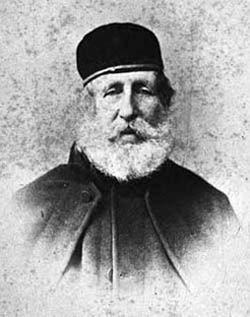
Wilbraham Frederick Evelyn Liardet
LaTrobe Library Collection
Liardet was a hotel keeper, water colourist and pioneer of Port Melbourne who was also instrumental in arranging some of the early regattas in Melbourne.
He served in the British navy and army reaching the rank of Lieutenant before retiring on half pay. In 1839, he and his family migrated to Australia. En route to Sydney, his ship stopped in Port Phillip and so did he.
He settled in Port Melbourne and commenced several businesses including collecting mail from ships and delivering to Melbourne thrice daily, established a hotel and also a carriage service to Melbourne. He was not a businessman and often failed. Fortunately his children were far more competent. Described by some as impetuous and a romantic, he was entertaining being a musician and sportsman. It has been suggested that his hotel guests were hospitably entertained but probably not billed.
He built a substantial jetty at Liardet's Beach, Port Melbourne to which passengers could disembark from their long journeys to Victoria.
As a promoter of early regattas in Victoria, he could claim to be a pioneer of rowing in Victoria.
Source: 'Liardet, Wilbraham Frederick Evelyn (1799–1878)', Australian Dictionary of Biography, National Centre of Biography, Australian National University, https://adb.anu.edu.au/biography/liardet-wilbraham-frederick-evelyn-2358/text3087, published first in hardcopy 1967, accessed online 14 May 2022
1844 regattas
Liardet again organised a regatta on 1st January 1844, again with most of the action off the water rather than on. There was again both rowing and sailing events, but neither were well patronised. Neale described the rowing races as follows: "The opening race was a rowing race of 5 miles for amateur oarsmen, the course being from the jetty at the Pier Hotel around the Glen tanner moored off William's Town, and return. The race was unusual in that one of the gigs was propelled by four oars, the other by six. Thomas Strode was one of the amateur rowers."8
In Geelong, there was good civic pride demonstrated by a desire to make the city Victoria's biggest port despite the sand bar across Corio Bay which was a significant deterrent for larger ships with too much draught to enter. It also gained a good reputation for organisation of sporting events - something missing from the Melbourne promoters of sport. Geelong held its first horse race meeting in 1843 and repeated it in 1844. They attracted visitors from Melbourne on the steamer. Then on the 11th March 1844, the following notice appeared in the Geelong Advertiser.
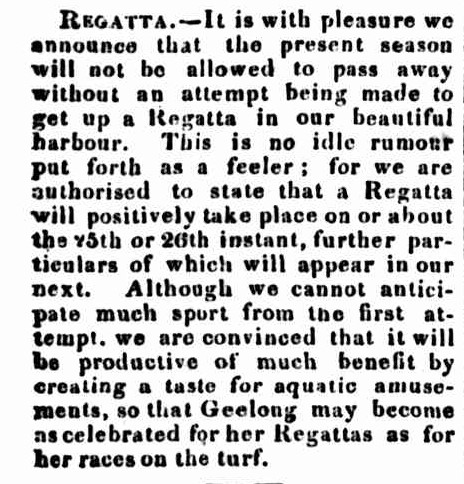
(1844, March 11). Geelong Advertiser (Vic. : 1840 - 1845), p. 2 (Morning.). Retrieved May 15, 2022, from http://nla.gov.au/nla.news-page8432781
Aquatics at Geelong duly commenced on Saturday 23rd March 1844 with a successful regatta. The Geelong Advertiser provided a full column to the description of the regatta on Monday 25th March announcing that whilst it "was not anticipated that the display would equal the older established Regattas in the colony, still, from the spirited manner in which the arrangements were planned and executed, the various races went off in a manner which called forth the admiration of the assembled spectators." Four races were contested, two sailing and two rowing. The first rowing race was for four oared cutters and gigs with four starters. The competitors were a mixture of watermen and gentlemen. The other rowing race was in whaleboats.
The Advertiser article finished with the following: "The day was closed by a grand regatta ball at Mr Strachan's, which, from the tasteful manner in which it was got up, far excelled any similar entertainment yet given in Geelong. The company separated at the discreet hour of twelve, with only this one regret - that twelve months must elapse before the next anniversary of the Corio Bay Regatta."
The Stewards for the regatta were Captain Wycherley, Charles John Dennys and Charles Sladen. They advertised for entries in the Advertiser on Thursday 21st Match 1844 noting that entries would be accepted on the morning of the regatta. Captain Wycherley was probably a visiting ship Captain as he is noted as the Captain of ships plying the Trans Tasman during this period. Dennys and Sladen were both well educated, ambitious and capable young men who were to become pillars of the business, government and religious life of the district. Both competed in the four oared gigs race. They are therefore pioneers of rowing in Geelong.
Charles John Dennys (1818-1898)
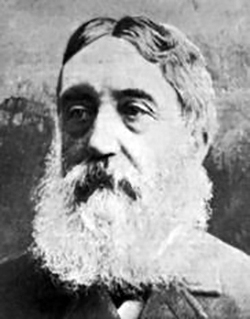
Charles was a farmer, stock and station agent, tallow manufacturer and wool broker. His fame and fortune arose from establishing the first wool auctions in Geelong and was a pioneer of Australian wool sales which eventually surpassed those of London by the mid 1890s.
For our interest, he was a pioneer of rowing in Geelong, being a steward of, and competitor at, the first Geelong Regatta on Corio Bay in March 1844. He was also a steward of the first horse race meeting in 1843.
Frank Strachan's biography of Dennys sums up this man of high achievement as follows: "His career showed strong talent, imagination and resolution. A successful businessman, he exploited the opportunities offered by the rich Victorian Western District, for the benefit of Geelong as well as himself, and he was an influential pioneer of the process whereby domestic sales of Australian wool surpassed London sales by the mid-1890s."
Source: Frank Strachan, 'Dennys, Charles John (1818–1898)', Australian Dictionary of Biography, National Centre of Biography, Australian National University, https://adb.anu.edu.au/biography/dennys-charles-john-306/text5149, published first in hardcopy 1972, accessed online 15 May 2022.
Sir Charles Sladen (1816-1884)
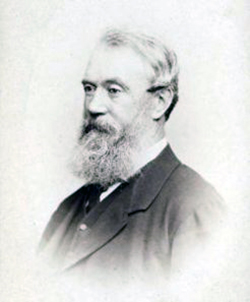
Charles Sladen by Johnstone, O'Shannessy & Co., 1870
La Trobe Picture Collection, State Library of Victoria, H29566
Charles was a leader in many areas of the infant Victoria. Anglican lay leader, company director, grazier (sheep), Member of Lower House, Member of Upper House, Victorian Treasurer, State Premier, sheep breeder and solicitor.
For our interest, he was a pioneer of rowing in Geelong, being a steward at, and competitor of, the first Geelong Regatta on Corio Bay in March 1844.
He was admitted LL.D., ad eundem, to the University of Melbourne in 1868 and was created C.M.G. in 1870 and K.C.M.G. in 1875.
Source: James Grant, 'Sladen, Sir Charles (1816–1884)', Australian Dictionary of Biography, National Centre of Biography, Australian National University, https://adb.anu.edu.au/biography/sladen-sir-charles-4589/text7541, published first in hardcopy 1976, accessed online 15 May 2022.
1845 regatta
As Melbourne was emerging from the financial disasters of the past years, enthusiasm for a regatta was low. The first race of the 1845 New Years Day regatta was a scurry race from Queen's Wharf. It was abandoned with the arrival of only one starter, the boat of Henry Taylor. The organisation of the regatta was poor and the regatta was unsuccessful.9 Despite the enthusiasm of 1844, Geelong was unable to organise a regatta in 1845 and had to wait until 1848 before recommencing aquatic activities.
1846 regatta cancelled
The 1846 regatta planning started will great enthusiasm but reduced to nothing by the time New Years Day arrived and so was cancelled. The funds subscribed for the regatta were low and were returned to subscribers. Probably the prize monies were too low to attract the necessary entries. This was before the era of racing for the joy of sport. The focus of sport in Melbourne was on horse racing.10
1848 - Geelong's second and third regattas
The organisation of the January 1848 Geelong regatta fell to the Captains of the visiting ships in port. The advertisement for entries listed prominent locals as the stewards of the regatta, namely: J S Hill, Cecil Byron (Geelong Coast Waiter and Tide Surveyor) and Charles Nantes (wine and spirit merchant and prominent public figure). It was a three day event when the Batchelor's Ball on the night before and the cricket match between Geelong and Melbourne cricketers the following day were added. The rowing events were supported by Geelong and Melbourne watermen.
With respect to the rowing events, a four oared whaleboat race was planned as was a four oared gig race. However, the wind was unfavourable and it was difficult to undertake the regatta. The sailing race and whaleboat races were conducted but with reduced entries.
Geelong also hosted another regatta in the Christmas week of 1848. A Melbourne regatta was planned at a similar time but was postponed until the New Year to avoid a conflict with the Geelong Regatta.
The Boxing Day Regatta was held as part of a wider range of activities in the then thriving town of Geelong. Geelong residents claimed that they were now the "Commercial Capital" of the Port Phillip colony. Despite a wider range of regatta events planned, bad weather intervened with rain, thunder and lightening dispersing the spectators. The newspaper commentary concluded that once the storm hit, "We cannot pretend to give more than the result of the closing races." Four races were conducted including a whaleboat race of not more than five oars, a waterman's sculling race.
1849 regatta
Despite Geelong organising two successful regattas in 1848, Melbourne's next regatta had to await until 1849, and even then, it was not a resounding success. The regatta was conducted on Tuesday 2nd January 1949 at William's Town. The first race was for ships' four oared gigs for professionals. The second race was for amateurs but none wished to compete. The professionals took over and raced and the Liardets won handsomely. The other rowing race was in whale boats with five oars. The watermen from Hobson's Bay won from Mr Liardet's crew with the winners of the recent Geelong regatta, a Corio Bay crew, in third place.11
1850 regatta
A later date was chosen for the regatta being Monday 11 March 1850. The regatta was conducted between the beach (now Port Melbourne) and William's Town. The patrons for the event included Judge a'Beckett, Melbourne Mayor Dr Augustus Greeves as well as the Captains in port at the time. The top prize of 20 pounds was for the whale boat race. The entries were again low: three whale boats, three dinghies rowed for a sweepstake, no gigs and only two sailing boats. The lack of support by Melbourne's watermen and visiting ships was evident.12
Footnotes
- (1841, January 30). Port Phillip Gazette (Vic. : 1838 - 1845), p. 3. Retrieved October 1, 2021, from http://nla.gov.au/nla.news-page23202805.
- Jolly Dogs Are We - The History of Yachting in Victoria 1838-94, by Ralph Neale, published by Landscape Publications 1984, pages 6 and 7.
- Ibid., 23.
- Ibid., 25.
- The Victorian Oarsman and Rowing Register by John Lang, published by A H Massina and Coy, Melbourne 1919, 23.
- Neale, Ibid., 31.
- Neale, Ibid., 36.
- Neale, Ibid., 39.
- Neale Ibid., 44
- Neale Ibid., 45
- Neale Ibid., 47
- Neale Ibid., 49
< previous Introduction
> next Chapter 2

